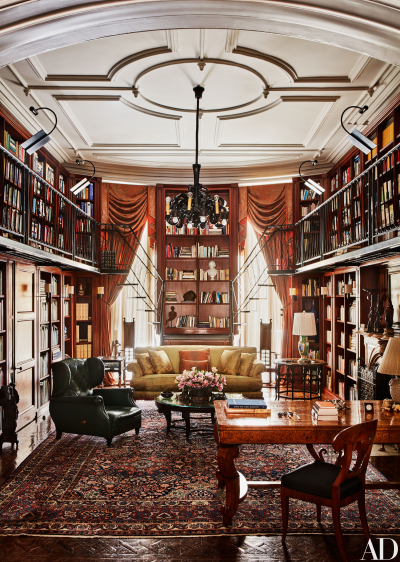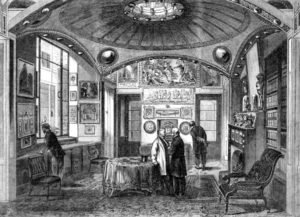
Couturier inserted a pair of arched doorways (one shown) to open up the living room to the entrance hall. Photo © Douglas Friedman/Architectural Digest.
Not long after my mother died, her best friend became a real-estate agent. Dorothy had enjoyed a successful career as a psychologist, but losing my mother made her too sad to take on additional depressed patients, she explained; what she had liked best about her work was snooping through the lives of strangers and helping solve their problems, and she figured she could do so equally well in this new career. When I returned to New York in the summer of 1992 from South Africa, where I had been reporting on the end of apartheid, I had a phone message from Dorothy, saying, “I’ve found the house you’re going to live in for the rest of your life. Call me as soon as you can.” I told her I wasn’t even sure I wanted to stay in New York. She said, “When you see this house, you’ll stay.”
The squalor was almost unimaginable. Graffiti covered the walls; leaking pipes projected from the ceilings; the roof had been taken off a room on the top floor, and the dangling roots of suspicious plants grew through the ceiling of what is now my bedroom. The place smelled alarming; I found a dead cat under one of the bathtubs when I took possession. The windows were so dirty that light could barely penetrate around the peace-sign decals that adorned them. Inexplicable Formica cabinets sagged in several unhygienic kitchens. But the scale was noble, and the decades of neglect meant that the lovely original features of the townhouse — fireplaces, carved balustrades, inlaid floors, detailed woodwork — had not been stripped out, as had happened to so many neighboring homes in the 1970s. I bought the property at a probate sale where there was only one other bidder.
I had written about design for some years and knew I wanted Robert Couturier to revitalize the house. I recognized his knack for intersecting volumes and his unerring sense of proportion: His work is steeped in refinement but not enslaved by it. He was sympathetic to my pretensions of grandeur and unfazed by my perfectionism. I can be rigid and uncompromising; Robert has a rare gift for being definitive but conciliatory. He had charmed me the first time I met him, and his effusive kindness and generous sense of humor would be essential for the huge project ahead. I was convinced that his wild imagination, coupled with his fathomless scholarship of architectural history, could turn this desolate wreck into someplace warm and exuberant. Moreover, I had lived in England for many years and wanted a house that didn’t feel altogether of New York, and Robert, with his singular ability to celebrate history without pandering to it, brought in a bit of Europe without being precious or coy.

The double-height library is an ode to Solomon’s love of books. The windows and Couturier-designed sofa are dressed in silk damask. Photo © Douglas Friedman/Architectural Digest.
Couturier inserted a pair of arched doorways to open up the living room to the entrance hall. Robert proposed that we punctuate the long, narrow living room with twin arches to the entrance hall. When we opened up the walls, we found brickwork for nearly identical apertures — proof of the rightness of his instincts. He added tall mirrors over the two fireplaces, and the room began to breathe; then he designed wall moldings to enliven the flat expanses subtly. I had always yearned for a double-height library, since books are my life. He figured out how to make the upper tier of bookcases seem almost to float, using a wrought-iron catwalk as delicate as a spiderweb.
He achieved coherence that encompassed the myriad acquisitions of my wide-ranging travels. He incorporated the tile panel I’d bought in Afghanistan into a bath wall and installed my panel of Chinese silk embroidery on the arched ceiling of the dressing room. Cloth woven in India from peacock feathers was to trim the dining room curtains; passementerie from Madagascar could be deployed in the living room; feather money from the Solomon Islands was framed for one of the baths; Mongolian chatelaines were positioned in the dressing room; and the Burmese begging bowl went onto a mantel. As Dostoyevsky wrote, “Beauty will save the world.” My work with Robert on this and other projects since has both reflected and profoundly influenced my personal aesthetic — and is enmeshed even in my sense of purpose.
I found my dining table, crafted by the Bath Cabinet Makers, when I was living in London in the 1980s. It was produced, I was told, in 1927 as a showpiece in order to secure a cabinetry contract for the great Cunard ocean liners. After it had been in the dealer’s window for over a year, I walked in one day and said, “I have just received an inheritance from my great aunt and can offer you half your asking price in cash today, but nothing more.” That afternoon, we found the table wouldn’t fit through the doors of my London house, and it went into storage. When I bought the New York place, my father dryly remarked, “I see you’ve finally found a house to go with that table of yours.” The Austrian Biedermeier chairs are astonishingly of a piece with it, though they are a hundred years older than the table. Robert helped me envision the dining room as an oasis of highly stylized serenity, lacquering the walls so that the space feels moonlit.
The house is unusually deep, and we had to figure out what to do about the middle of it, where there is almost no natural light. On the first floor, the depth is swallowed by the long living room; on the third floor, it was a natural location for the dressing room and baths; and on the top floor, a terrace garden opens up the space. But the second floor, which was a warren of closet-size rooms when I found the house, was a mystery.

When Robert suggested that he could make the small rooms into a large square one, I mentioned how much I loved John Soane’s breakfast room; he then devised a domed aerie, with arches opening onto the dining area, where we could have more intimate meals. He promised that it would be incredibly pleasing to sit in, and it is. A few years later, through a mutual friend, I met the mosaicist Farley Tobin, and we concocted a plan to tile the ceiling and the panel surrounding the French stone fountain that sits in an arched niche on one wall. It took ten years. Crews of Tibetan tileworkers were up on scaffolding at all hours of the night on an erratic and bewildering schedule. The intricacy of the small patterns within the tilework is a triumph not only of Farley’s art but also of her mathematics.
I had bought two carved-wood panels at a Beijing flea market, back when those markets were still full of treasures. William Sofield incorporated them into a canopy bed, and Robert worked out the rest of the chinoiserie in the master bedroom. Robert also vaulted the the dressing room ceiling and devised in my bath the complex layout of antique Iznik tiles I had bought in Turkey. He did the concept drawings for the Indian-inflected upper terrace and designed the railing; the planting is by Barbara Blechman, whose sense of restrained effusion has created a paradise far removed from the bustle of Manhattan.
I was already established here when I met my husband, John Habich Solomon, 16 years ago. When John moved in, he would occasionally suggest changes, brightly venturing, “What would you think of moving that picture six inches to the left?” I would rejoin frostily, “If I had thought it would look better there, I would have hung it there in the first place.” Robert, as keenly attuned psychologically as he is visually and a cherished friend to us both, helped resolve such issues so that the house gradually came to reflect both of our sensibilities. It is in a state of permanent evolution, and those changes I once resisted have come to feel like a cheerful conversation between John and me.
Then our son was born. Though we have three other children, who visit often but do not live here full-time, George, now seven, to whom Robert is an honorary godfather, introduced welcome chaos. We learned to tolerate the profusion of Lego bricks in some rooms, the general bouncing by which our velvets were rapidly subdued, a trail of soccer balls and miscellaneous chapter books. People have asked if I mind having such disruption of the precision I’d maintained before we became parents. Mostly, I don’t. The genius of Robert’s work is that the grand, underlying order he established in the house is revealed only more fully when such joyous pandemonium interrupts the hegemony of its elegance.
(To view the complete seventeen-image slideshow, please visit Architectural Digest.)











